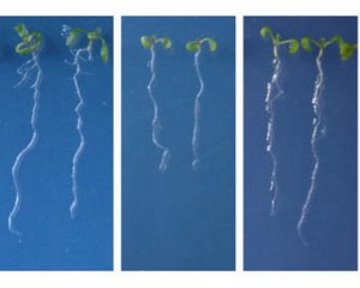May 22, 2009 Research Highlight Biology
Many ways to grow
Environmental conditions may determine which particular process plants will use to build an essential hormone
 Figure 1: Effects of disrupting the CYP79B pathway. In comparison to normal Arabidopsis plants (left), plants with a disrupted CYP79B pathway show reduced growth at higher temperatures (middle). However, treating mutant plants with indole-3-acetamide (IAM), an intermediate between IAOx and IAA, restores normal growth (right). Reproduced from Ref. 1 © 2009 by the National Academy of Sciences
Figure 1: Effects of disrupting the CYP79B pathway. In comparison to normal Arabidopsis plants (left), plants with a disrupted CYP79B pathway show reduced growth at higher temperatures (middle). However, treating mutant plants with indole-3-acetamide (IAM), an intermediate between IAOx and IAA, restores normal growth (right). Reproduced from Ref. 1 © 2009 by the National Academy of Sciences
For the better part of a century, scientists have recognized indole-3-acetic acid (IAA), one of several hormones known as auxins, as one of the most important drivers of plant growth and development. However, it remains unclear exactly how IAA is synthesized. Previous research has identified at least four different enzymatic ‘assembly lines’ that may be involved in its production, and each of these pathways generates chemical compounds that are potential precursors to IAA, as well as a number of other biologically important molecules involved in protecting plants against predators and pathogens.
In the thale cress plant, Arabidopsis thaliana, indole-3-actaldoxime (IAOx) is thought to represent a likely intermediate compound in IAA production via two of these candidate pathways, CYP79B and YUC. In order to clarify which of these contribute primarily to production of IAOx and IAA, Hiroyuki Kasahara of the RIKEN Plant Science Center in Yokohama and colleagues generated several mutant Arabidopsis strains in which key enzymes in either pathway had been ablated.
From the data, the team consistently identified an exclusive role for the CYP79B pathway in IAOx production and—by extension—IAA synthesis, and demonstrated no effect on levels of either compound resulting from interference with YUC-associated enzymes1. They also identified two compounds, indole-3-acetamide and indole-3-acetonitrile, as likely intermediates in the conversion of IAOx to IAA (Fig. 1). Many plant species, including tobacco and rice, lack the CYP79B pathway altogether and do not produce detectable IAOx. However, these plants do produce these other IAA intermediates, suggesting the existence of yet-unidentified, parallel biosynthetic pathways in these species.
These findings indicate the need for a considerable reorganization of existing models of plant hormone synthesis. “Before this research, three proposed pathways were thought to converge at IAOx or its metabolites,” says Kasahara. “We have clearly separated these pathways.” Interestingly, their data also revealed that even in Arabidopsis, CYP79B does not represent the primary pathway of IAA production; instead, it is simply one of several that appear to contribute under different, specific conditions—in this case, cultivation at higher than room temperature.
Other non-IAOx biosynthetic pathways appear to be common to most plant species and Kasahara and colleagues now hope to clarify their independent contributions to overall IAA production. “We do not know why plants have so many biosynthetic pathways for IAA,” he says. “Here we showed that the IAOx pathway contributes to IAA generation under high temperature conditions, and now we are studying the physiological roles of other IAA biosynthetic pathways.”
References
- 1. Sugawara, S., Hishiyama, S., Jikumaru, Y., Hanada, A., Nishimura, T., Koshiba, T., Zhao, Y., Kamiya, Y. & Kasahara, H. Biochemical analyses of indole-3-acetaldoxime-dependent auxin biosynthesis in Arabidopsis. Proceedings of the National Academy of Sciences USA 106, 5430–5435 (2009). doi: 10.1073/pnas.0811226106
